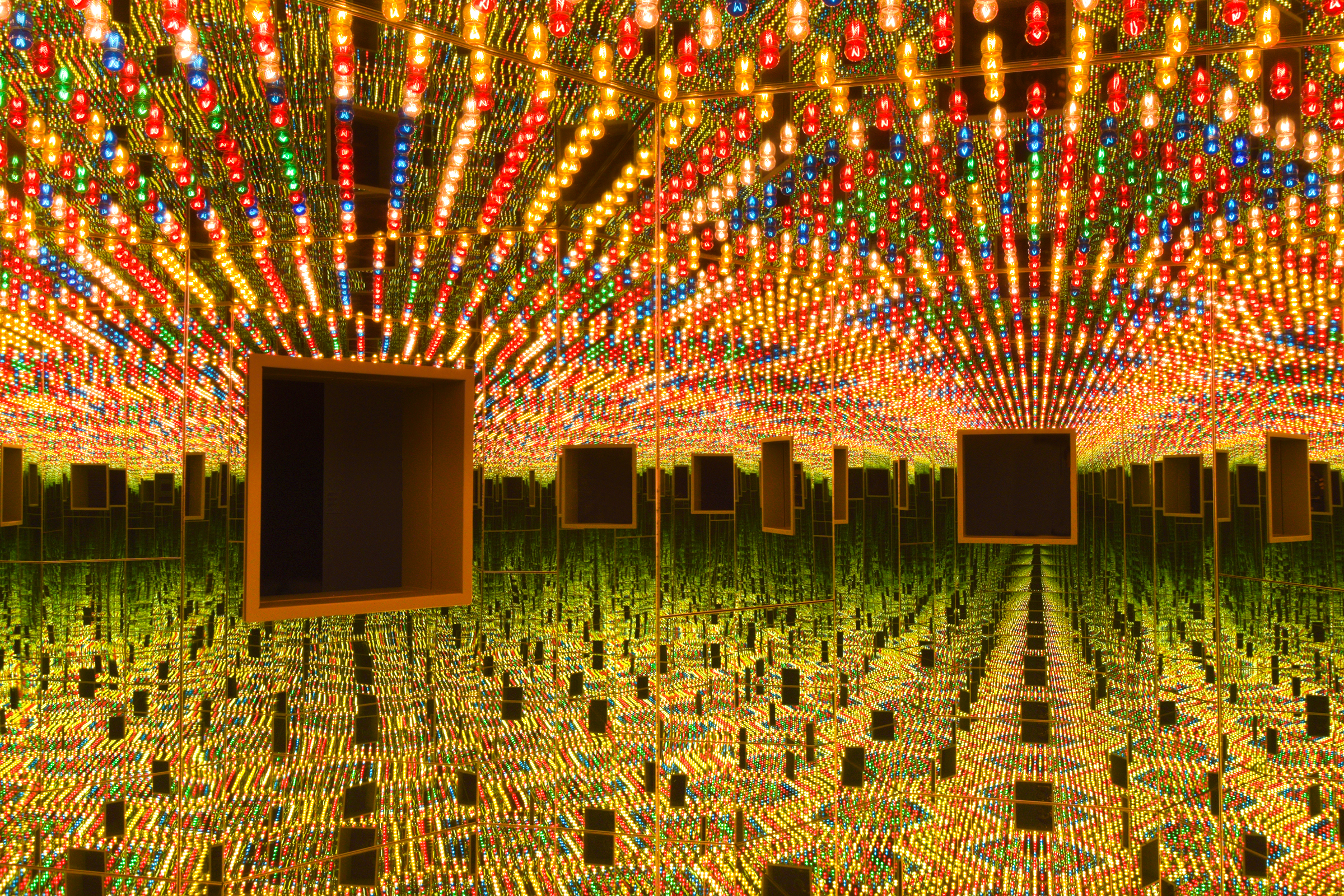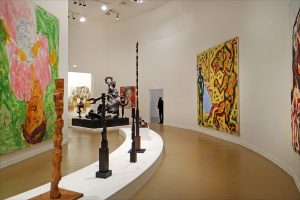When people step inside one of the plain, fifteen-square-foot boxes at the Yayoi Kusama: Infinity Mirrors exhibit at the Hirshhorn Museum, they discover an endless world of lights, colors, and patterns.
Born in Matsumoto, Japan in 1929, Kusama moved to New York in the late ‘50s, where her popular abstract and experimental style brought her into contact with other artists such as Andy Warhol and Allan Kaprow. After years of creating avant-garde sculptures, painting polka dots on naked bodies, and some financial troubles, Kusama returned to Japan in the ‘70s, spending some time at a mental institution. Since leaving the institution, Kusama has further developed her artistic style. She uses art as both a therapeutic and expressive medium, and has recently created several more pieces, adding most notably to her collection of infinity rooms. Last year, Kusama was named one of Time Magazine’s Most Influential People. Her art gives the viewer insights into the artist’s own exciting and tumultuous history while providing an immersive medium for personal reflection.
For Kusama, art is a way of recording or deciphering the events of her life, dealing with her anxieties, and healing. For instance, “All the Eternal Love I Have for Pumpkins” provides an innocent, ethereal account of her childhood and the first time she saw a pumpkin at a farm with her grandfather. The piece pairs a childhood memory with Kusama’s polka-dot motif, creating a storybook sensation while endlessness of the mirrors evokes a sense of freedom. On the other hand, “Phalli’s Field”, Kusama’s first Infinity Mirror room, features several soft, white phallic sculptures. The mirrors give create an endlessness to the piece, which is a new evolution after several years of sculptures with a phallic theme intended to help her confront her fear of sex and phalluses.
The exhibit is laid out chronologically, beginning with the earlier works and depicting the evolution of certain themes such as polka-dots and phallic shapes. Her earlier phallus-inspired sculptures from the ‘60s, belonging to the “Accumulations” series, are made out of soft, white cloth material. When Kusama revisited the theme in the ‘70s, she began to paint the sculptures silver, as can be seen in “Snake.” The reflective nature of the silver paint helped contribute towards the idea of the Infinity Mirror Rooms.
Kusama’s most beloved theme is polka-dots—the Hirshhorn has even decorated its windows with red polka-dots in her honor. Several of her sculptures, paintings, and infinity rooms include the motif, such as “All the Eternal Love I Have for Pumpkins”, “Phalli’s Field”, and of course, “Love Transformed into Dots.” This piece includes several inflated three-dimensional pink polka dots covered in two-dimensional black polka dots. Kusama plays with the size of the polka dots to create an interesting visual effect of layers of polka dots within polka dots. The infinity room in this piece is one of the pink spheres that is a part of the largest outer layer of polka dot spheres and contains another layer of smaller polka dot spheres. After the infinity room, viewers can continue searching through the layers of polka dots and look through a peephole containing tiny, neon-lit pink polka dots. A recording of Kusama singing one of her poems plays in the background, adding a calming and personal touch.
In the infinity room “Love Forever”, created in 1966, Kusama makes a political statement. The message “Love Forever” demonstrates solidarity with civil rights and sexual liberation movements as well as opposition to the Vietnam War. Two people can look into this infinity room at once and see each other reflected endlessly. The infinite projection of the image of another individual as well as the colorful neon lights, which make the room physically warm, create a focus on the other person that elicits empathy and respect for that individual.
Showing a more introspective side of Kusama, the Infinity Mirror room “The Souls of Millions of Light Years Away” creates the illusion of floating in a peaceful and beautiful galaxy in outer space. Kusama developed it in an effort to further explore the finite nature of life and the certainty of death. The immersive dimension of the infinity rooms effectively shares her stories, interests, and curiosities with viewers and invites them to question their own narratives and thoughts on these universal questions.
Similarly, “Aftermath of Obliteration of Eternity” alludes to a Japanese tradition in which paper lanterns are sent along a river to float to the spirits of deceased ancestors. This is arguably Kusama’s most beautiful piece. With only white lights inside paper lanterns hung at different heights, this infinity room is simpler than some of the other more colorful or playful rooms, because besides the lanterns, the rest of the space is completely dark. It is the one that elicits the most calm and the most introspection and, like “The Souls of Millions of Light Years Away,” presents Kusama’s fascination with questions of death and afterlife.
Kusama’s immersive pieces are engaging and fascinating. They allow for a heightened level of connection with the artist and personal reflection. This is art that is accessible, beautiful, and thought-provoking. So far, the exhibit has been incredibly popular in D.C., so much so that the time in the infinity rooms has been limited to thirty seconds to keep lines moving. The short viewing periods leave viewers wanting more. Nonetheless, for those thirty seconds, they’re transported to another world, suspended in Kusama’s beautiful, endless environments that provoke internal reflection.





